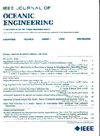Automated Amplitude and Phase Attribute-Based Horizon Picking Applied to 3-D Sub-bottom Data
IF 5.3
2区 工程技术
Q1 ENGINEERING, CIVIL
引用次数: 0
Abstract
The 3-D sub-bottom profiler (SBP) is widely used for observing sub-bottom structures due to its high resolution and spatial coverage. However, traditional picking methods are limited by scattering noise and imbalanced intensity, resulting in poor picking of reflections with weak intensities and overpicking due to scattering noise. This limitation has hindered the development of 3-D SBP processing technologies relative to the widespread applications. In this article, we present a 3-D SBP horizon-picking method that takes into account both amplitude and phase information. First, we apply an amplitude data enhancement filtering algorithm considering the plate-like structure and the nonvertical characteristic to avoid scattering noise interference and highlight plate-like horizon features. Subsequently, a threshold-based algorithm is applied to pick the amplitude horizons, reflecting the main structures of layer interfaces based on the processed amplitude data. Then, the local phase information of the SBP data is derived through the monogenic analysis, and phase horizons are picked, which can describe detailed reflections with weak intensities, although overpicking may occur. To leverage both amplitude and phase horizons, a combination method is proposed to ensure continuous and fine horizon picking containing both main and detailed 3-D SBP horizon structures. The method was validated by comparing automated horizon results with manual results using experimental data. A total of 87% and 86% F-measures were achieved on two data sets, respectively.基于振幅和相位属性的自动水平拾取技术在三维亚底数据中的应用
三维海底剖面仪(SBP)以其高分辨率和空间覆盖范围广泛应用于海底构造观测。然而,传统的拾取方法受到散射噪声和强度不平衡的限制,导致对弱强度反射的拾取效果差,并且由于散射噪声而导致过拾取。这一局限性阻碍了三维SBP处理技术的发展,使其无法得到广泛的应用。在本文中,我们提出了一种同时考虑振幅和相位信息的三维SBP水平提取方法。首先,采用一种考虑到平板结构和非垂直特性的振幅数据增强滤波算法,避免散射噪声干扰,突出平板水平特征;然后,基于阈值算法选取振幅层,根据处理后的振幅数据反映层界面的主要结构。然后,通过单基因分析得到SBP数据的局部相位信息,并进行相位层位的提取,虽然可能会出现过挑,但可以描述弱强度反射的细节;为了同时利用振幅和相位水平,提出了一种同时包含主要和详细三维SBP水平结构的连续和精细水平拾取方法。利用实验数据对比了自动地平与人工地平的结果,验证了该方法的有效性。在两个数据集上,f测量值分别达到87%和86%。
本文章由计算机程序翻译,如有差异,请以英文原文为准。
求助全文
约1分钟内获得全文
求助全文
来源期刊

IEEE Journal of Oceanic Engineering
工程技术-工程:大洋
CiteScore
9.60
自引率
12.20%
发文量
86
审稿时长
12 months
期刊介绍:
The IEEE Journal of Oceanic Engineering (ISSN 0364-9059) is the online-only quarterly publication of the IEEE Oceanic Engineering Society (IEEE OES). The scope of the Journal is the field of interest of the IEEE OES, which encompasses all aspects of science, engineering, and technology that address research, development, and operations pertaining to all bodies of water. This includes the creation of new capabilities and technologies from concept design through prototypes, testing, and operational systems to sense, explore, understand, develop, use, and responsibly manage natural resources.
 求助内容:
求助内容: 应助结果提醒方式:
应助结果提醒方式:


